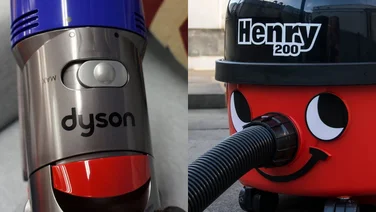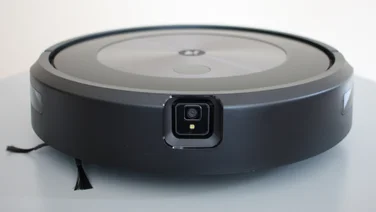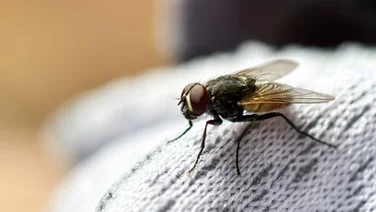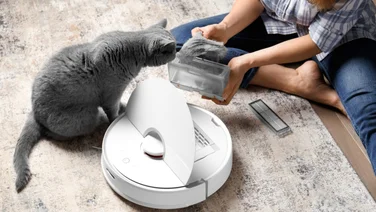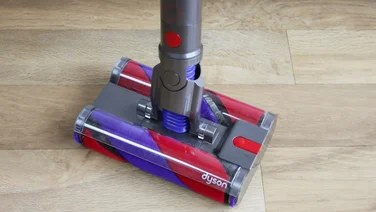To help us provide you with free impartial advice, we may earn a commission if you buy through links on our site. Learn more
- Dyson Light Ball Multi Floor review: Price and competition
- Dyson Light Ball Multi Floor vs Dyson Light Ball Animal
- Dyson Light Ball Multi Floor review: Design and features
- Dyson Light Ball Multi Floor review: Accessories
- Dyson Light Ball Multi Floor review: Performance
- Dyson Light Ball Multi Floor review: Verdict


































- Excellent cleaning results
- Relatively quiet
- Bagless design prevents dust from resurging
- Heavy to lug around and maneuver in small rooms
- No unified storage for accessories
- The ball won’t fit under all furniture
In 2017, the EU commission banned vacuum cleaners that exceeded 900W. Prior to the ban, the maximum power was 1,600W. By effectively halving the total power draw, Europe as a whole would supposedly save a lot of energy (around 20TWh of electricity per year), which would result in lower electricity consumption and pollution, while forcing manufacturers like Dyson to become more energy efficient.
The British-born company has responded with its very own creation: the Dyson Light Ball Multi Floor. Much like a car, Dyson vacuum cleaners have their own set of specifications. Here, we have a 700W motor, a 1.6-litre capacity bin and an A-class energy efficiency rating.
That’s not bad on paper, but how does it do in real-world tests?
Dyson Light Ball Multi Floor review: Price and competition
The Light Ball Multi Floor costs just under £200 from a variety of UK retailers, including Amazon, Argos, Currys and Dyson itself. At the time of writing, it’s available for £179 at John Lewis.
Oddly enough, the Light Ball Animal – which is exactly the same machine, just with the inclusion of a Tangle-Free Turbine Tool (worth £40) and a different colour scheme – is currently £200 at Currys, John Lewis and from Dyson directly, too. So, straight off the bat, if you’re looking to get the Light Ball Multi Floor, don’t. Get the Animal instead – I’ll explain why later on in this review.


































It’s also worth considering the Dyson Small Ball Total Clean at £235. This has 900W of power, which doesn’t exceed EU regulations, and is limited to a smaller 0.8-litre bin capacity. There’s also the Ball Animal 2 at £300. This has 700W of power and a larger 1.8-litre bin but isn’t designed to work across wood flooring.
If you’re worried about longevity, Dyson offers a five-year warranty on all of its products.
Dyson Light Ball Multi Floor vs Dyson Light Ball Animal
To make the differences slightly clearer between the two models, I’ve created a comparison table:
| Dyson Light Ball Multi Floor | Dyson Light Ball Animal | |
| Price | £200 | £260 |
| Power | 700W | 700W |
| Bin capacity | 1.6 litres | 1.6 litres |
| Tangle-Free Turbine Tool | No | Yes |
| Washable filters | Yes | Yes |
| Energy efficiency class | A | A |
| Dust re-emission class | A | A |
| Sound level | 80dB | 80dB |
| Colour scheme | Iron & Yellow | Iron & Purple |
| Weight | 6.9kg | 6.9kg |
| Warranty | 5yrs | 5yrs |
Dyson Light Ball Multi Floor review: Design and features
The company’s first-ever ball design stretches back over a decade – are you feeling old yet? The same basic design, with a few improvements, is featured on the Light Ball Multi Floor. It hasn’t changed much because it works, at least most of the time. This upright vacuum cleaner is easy to manoeuvre around large objects and moves freely in a straight line. It’s only when you place it in a cramped room, with less space to manoeuvre, that cleaning becomes a real chore. Thankfully, you can take out the hose for such scenarios (more on this below).


































Despite the company’s claims of portability, the 6.9kg Light Ball Multi Floor is hard to twist and turn over a long period of time. Sure, a short 10-minute clean isn’t a problem, but if you’re going to be cleaning the house or multiple rooms, you’ll find it hard to keep up without straining your wrist. The famous ‘Ball’ itself is also relatively large, so it won’t fit under all furniture, which is worth considering if, like me, you’re used to shoving the vacuum nozzle under a bed.
Unlike traditional vacuum cleaners, carrying the Dyson up a flight of stairs is easy. Thanks to its bin handle, which is recommended for lifting, the Light Ball Multi Floor can be transported with one hand only. That frees up your second hand for tea, coffee or Dyson’s accessories.


































That leads me neatly onto the allocated storage space for tools. If you’re looking to transport all the cleaning heads with you, you’ll need to place a few of them in a bag, so you won’t be bagless – see what I did there? Jokes aside, it is a problem that there’s no unified storage for all your cleaning heads, which means you’ll have to place a few on the Dyson (on the tool holder on the bottom-left-hand side) and leave the others to be sacrificed to the gods of storage cupboard. My own seven-year-old Miele S6290 vacuum cleaner comes with a plastic storage unit for all its accessories, so it’s safe to say that Dyson has missed a trick here.


































Speaking of rival vacuum cleaners, I found the lack of a cable-rewind module on the Dyson frustrating. Instead of magically rewinding the cable into the unit, the long power cable needs to be wrapped around the plastic inserts of the vacuum cleaner and I fear that with time and use these bits will snap. In fact, the use of plastic throughout the Light Ball Multi Floor is disappointing. On one hand, I understand the company is trying to keep the weight down, but this just doesn’t feel like a premium vacuum cleaner.
If all this sounds rather negative, rest assured that Dyson’s bagless technology is a winner. I suffer from different allergies, one of them being house dust mites. The result? whenever I vacuum with my Miele S6290, I sneeze. With Dyson’s bagless vacuum cleaner, things are different. It’s definitely the best in the business for those, like me, that suffer from airborne dust-related allergies. Using the machine for over an hour, there was a breath of fresh air around the room. It really sucks up all the unwanted dust and it doesn’t resurge. There’s no surprise then, that it scores an ‘A’ rating for dust emissions.


































As for the bin, the process of removing it and emptying it in the dustbin couldn’t be simpler, although there’ll inevitably be some dust when you empty out the bin. The 1.6-litre capacity is perfect for a long cleaning session, and while your mileage may vary, I was able to clean four rooms, two quite dirty, in one session. Flooring can affect the total number of rooms you can hit in one go, but given that the process of emptying the vacuum bin is simple, I can’t see why anyone would complain.


































The Dyson Light Ball Multi Floor’s filters are also very easy to remove and clean. They can be washed (outside of the machine), and need around a day to air-dry, but this means you won’t need to buy additional filters. Dyson recommends cleaning the filters once a month.
Dyson Light Ball Multi Floor review: Accessories
This model comes with several tools, starting with a stairs tool and a combination tool comprised of five separate parts. There are two brush heads, one that’s slightly smaller than the other; two crevice tools, one of which has an extendable flexible section that’s ideal to reach around objects; and a zigzag dusting brush tool that’s made for cleaning your wardrobe surface or behind the telly.


































These tool heads are attached to the Dyson’s hose or at the end of the plastic wand. Here, the 90cm plastic piece is a little hard to use in tight areas but perfect for those hard-to-reach parts of the house, such as the ceilings. Its expandable hose stretches to around 3m, which is almost enough to reach the top of a flight of stairs in the UK (generally 12 in a general access staircase).
When using the stretchable hose in and around a room, the machine would follow me around, as there’s a certain tension between the main body and the hose. This isn’t a problem when used on a flight of stairs, but you’ll want to position the Dyson behind a bed or an unmovable object when cleaning all the nook and crannies in a room.


































The main accessory is the variable suction tool, which has three different levels of intensity. Set it to ‘+’ or ‘Max Mode’ and it’ll dig deep into thick carpet. You can set it to medium for everyday surfaces, and ‘-’ for hardwood flooring or delicate surfaces.
READ NEXT: Best cordless vacuum cleaners: Banish dust and dirt without the wires
Dyson Light Ball Multi Floor review: Performance
To switch on the Dyson, you simply press the big red button. If you’re cleaning very delicate surfaces and don’t want the revolving brushes to damage your flooring, you can deactivate it by pressing the silver button. This limits the Dyson to suction only.


































Let’s first talk about the suction power; a much-debated topic under the new regulations. In terms of raw power, I find the Dyson sits a tad behind my trusty 1,200W Miele S6290. Here, my old Miele would suck up a lot of dust, even if the nozzle wasn’t placed flat on a surface – for example, passing the extended nozzle under a wardrobe, or cleaning out my desktop PC.
However, the tides turn when I conduct tests in a more traditional sense. The Dyson outperforms the Miele in single- and double-pass takes over hardwood and carpet flooring, ensuring that you don’t have to redo certain areas of the floor. Thanks to its different modes, the Dyson is also better equipped to handle all types of flooring.


































When faced with horrible cat litter, the Dyson doesn’t leave any residue behind, although I did have to pass the vacuum cleaner over slowly or more than in order to suck up everything. The most impressive thing here is that it doesn’t snowplough anything. It keeps everything neat and tidy, even on tricky hardwood flooring.


































The Dyson also has excellent front-edge cleaning. For instance, cleaning by the kitchen’s skirting boards head-on was simple, and didn’t require me to fetch the crevice tool. It’s not quite as perfect with side-edge cleaning, which involves passing the head in parallel with the wall’s edge, but that’s a common issue for upright models.
Both the Dyson and the Miele struggles with thick pet hair. Here, Dyson’s Tangle-Free Turbine Tool would be a godsend, but that’s an additional purchase with the regular Light Ball Multi Floor. If you have pets or humans in the household that shed a lot of long hair, I’d suggest opting for the Light Ball Animal, instead. It’s essentially the same machine but with the Tangle-Free Turbine Tool thrown in.


































The Dyson’s overall performance is impressive, to say the least, and one shouldn’t forget it has a smaller 700W motor, yet outperforms other upright vacuum cleaners that have close to double the advertised power.
As for noise, the Dyson abides to the EU’s 80dB regulations, and it stayed pretty quiet throughout my tests. I still wouldn’t clean the house in the middle of the night, but it’s certainly a lot more bearable than the 1,200W Miele.
READ NEXT: Dyson Cyclone V10: The upright vacuum killer
Dyson Light Ball Multi Floor review: Verdict
The Dyson Light Ball Multi Floor is one of the best upright vacuum cleaners I’ve ever come across. Sure, it isn’t flawless, and I feel the British-born company could do by addressing some practical concerns, but the overall experience is seriously impressive, especially when it comes to cleaning performance.
So, if you’re looking for the best upright vacuum cleaner for under £200, this is it. Just remember that if you can find the Light Ball Animal at the same price, then go for that instead. You’re getting the same machine but with the Tangle-Free Turbine Tool thrown in for free.



